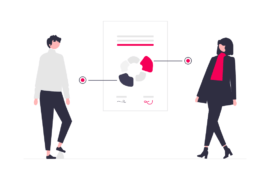For many years, display advertising has ruled the ad market. But then, native advertising came and changed everything.
Due to its high efficiency, advertisers now opt for native ads over banner ads. However, some advertisers are still comfortable with display advertising and are not ready to switch. This leaves publishers in a position where they need to create ad space for both display and native ads. As we’ve always said, the ad tech industry is complex.
Let’s dive deep into understanding the difference between native and display ads.
What Are Display Ads?
When you visit any website, you see small and large ads across the web pages. These are display ads. Display ads are often referred to as banner ads and have been used for more than 2 decades now.
These ads are often placed along with the original content with the brand’s logo to get visitors’ attention. Display ads can have varied sizes, types, formats, and more.
The first display ad was a banner ad for AT&T, served by Hotwired in 1994. Since then, the advertising methods only evolved, and the industry saw a great surge in publishers wanting to put ads to their platforms/websites.
Advertisers used text, images, audio, video, and other multimedia to make ads more impactful. Display advertising quickly becomes popular. For a long time, nothing was able to take away the fame from display ads, until native advertising appeared.
What Are Native Ads?
As the name suggests, native ads are designed to feel and appear like the original (native) content of the website. You must have seen native ads in the form of ‘suggested’ or ‘promoted’ content.
Native ads easily blend in the website content without distracting the visitors from the original content. For publishers, it reduces banner blindness and increases the chances of getting a click.
However, the downsides of native advertising include negative awareness for the original brands.
Also Read – Guide to Creating and Running Native Ads in Google Ad Manager
Difference Between Native Ads and Display Ads
Speaking on native ads vs display ads, we can’t miss discussing their differences. Let’s take a look at a few of the differences they share with the following table.
| Native Ads | Display Ads |
|---|---|
| Blends in with surrounding content | Stands out from surrounding content |
| Appears as sponsored content | Appears as banner ads or other visual formats |
| Non-intrusive approach | Attention-grabbing approach |
| Often used for promoting content or products | Often used for promoting products or services |
| Builds awareness and credibility | Generates leads or sales |
| Can be highly targeted to specific audiences | Can reach a broad audience across multiple sites |
| Matches the look and feel of the publisher’s site | Designed to stand out visually |
| May have lower click-through rates | May have higher click-through rates |
When to use Native Ads
Since native ads blend with the content, making it tough for the users to understand whether or not it’s an ad, it should be used strategically. For certain advertising goals, it can work wonders. Let’s take a look.
- Native ads are best used for promoting content or products non-intrusive, and organic.
- They also work well in contexts where users are likely to engage with informative or educational content.
- Next, native ads are ideal for brands that want to build awareness and credibility through storytelling.
- They can effectively reach a specific audience segment, such as tech enthusiasts or fashion lovers.
- Lastly, native ads typically appear as sponsored content that blends in with the look and feel of the publisher’s site.
When to use Display Ads
Unlike native ads, display ads appear to be different. They stand out from the content and grab the user’s attention with bold imagery, animation, or other eye-catching elements. Here’s when you should employ the use of display ads.
- If you’re looking forward to promoting your products/services more directly, attention-grabbingly.
- Display ads also work well in contexts where users are in a browsing or shopping mindset
- They are ideal for brands that want to showcase their products visually and generate leads or sales.
- Next, they can be very effective in reaching a broad audience across multiple sites and channels.
- Lastly, they typically appear as banner ads or other visual formats that stand out from the publisher’s site.
That being said, let’s delve deeper and understand how it affects the audience.
Effect On Audience
Image Source: MarwickMarketing
Visitors see and interact with native ads the way they interact with the web content. Here are some stats to show how visitors feel about native ads and display ads:
- Visitors look at native ads 53% more than display ads.
- 25% of visitors remembered seeing native ads whereas, for display ads, the percentage is 20%.
- For native ads, 32% visitors said, “an ad I would share with a friend or family member” versus 19% for display ads.
Many visitors have suggested they have no problem with ads displayed on their web pages until they hinder with their ongoing tasks. This is one of the reasons why more than 70% visitors have voted that they dislike pop-up ads.
The misuse of display ads has created a bad reputation for them calling them as “banner ads are bad.”
On the other hand, native ads are gaining a good reputation because of its content loving approach to show ads. These ads create awareness without blocking the main content.
But again, native advertising is also not the perfect solution. Visitors are now aware of the fact that ‘sponsored’ posts are advertisements. Sometimes, visitors click on ‘sponsored’ link thinking it as website content, but they immediately leave feeling cheated when redirected to another website.
Also read: Guide to Creating and Running Native Ads in Google Ad Manager
Advertisers’ Choice
Native ads showed 18% and 9% increase in purchase rate and brand affinity respectively than banner ads. Also, 71% visitors clicked on native ads and purchased the product whereas, for display ads, it was 50% visitors.
The advertisers generally go according to audience behaviour. If the audience is thinking native ads are good, advertisers will likely choose native ads over display ads.
However, native ads are not a recommended way to spread awareness of a brand. Because native placement of the ads takes away the brands’ flair, making the ads resemble website content rather than a marketed product. To overcome this problem, advertisers need to be creative while putting the content for native ads.
Moreover, display advertising still holds a big chunk of advertisers. As said earlier, most advertisers are comfortable with display advertising. Also, switching to native from display advertising requires a lot of manpower to design, monitor and run tests to get positive results.
From the above points, it can be said advertisers are still figuring out whether to go for native ads or display ads. However, it’s clear to advertisers that native ads bring traffic and display ads is great for remarketing campaigns.
Also Read – 7 Best Examples of Native Ads You Ever Wanted to Know
Everything Publishers Should Care About
For most publishers, displaying ads is the primary way of making money. They are confused about which advertising method (native or display) to implement on their platform.
Testing can help find out which advertising method is more effective. Some publishers often make the mistake of implementing a method just by listening to market rumors (like native ads are generating more revenue) and not running proper tests, first.
This is not the ideal way. It’s possible that native advertising is working for most publishers. However, that doesn’t mean it’ll be the same for all publishers.
Total visitors, average session duration, bounce rate, and page views are the most important metrics to test your advertising methods. If a method is gaining more visitors but increasing bounce rate then it’s no good.
Using Native Ads And Display Ads, Together
It might sound like a nice idea. Although, if you put native ads and display ads together, make sure you are ready to experience varied results at first. Meaning native ads have shown to increase the bounce rate. Hence, this can affect the overall revenue generation.
For publishers, using both methods can be hectic as publishers are required to spare space for both native ads and display ads. Moreover, getting in touch with advertisers interested in both native ads and display ads can be tricky. Not to forget, most publishers are already connected with various ad networks. This adds more to the management.
Takeaways
To conclude, here’s the difference with key findings on native ads vs display ads:
| Native Ads | Display Ads |
|---|---|
| Ads appear similar to published content bringing out the look and feel of the website. | Ads stand out from the website and its content bringing out the feel of brand mentioned in ads. |
| Audience reads native ads as web content hence increases CTR. | Audience ignores banner ads causing banner blindness hence lower CTR. |
| Ideal to drive traffic to the brand/product | Ideal for remarketing campaigns |
| Native ads require designing to match editorial content, which makes it hard & time-consuming to place ads on multiple sites | With display ads, advertisers can design one banner ad and place it on multiple publishers web pages |
| Visitors tend to trust the native ads more than display ads | History of display ads makes visitors think before clicking on ads |
| Design and look of the ads are restricted in order to match the host website | Display ads allow designing interactive ads which can be further tested to get best results |
Native advertising is surely offering some great benefits over display ads. But in the battle of native ads vs display ads, it’s too early to say that native advertising is going to consume the display ad market.
FAQs – Native Ads vs Display Ads
Display ads are traditional ads that appear as banners or pop-ups on websites. Native ads, on the other hand are designed to match the look and feel of the website they’re on to provide a more seamless and organic advertising experience.
It’s a type of advertisement, which blends in with the surrounding content and mimics the style and format of the platform on which it is displayed in order to provide a more organic and less intrusive advertising experience for the viewer.

Deepak has a keen eye for detail and a deep understanding of the ad tech landscape. Whether it’s through in-depth articles, thought-provoking insights, or compelling storytelling, he’s dedicated to helping people navigate the complex world of ad tech with the simplicity of his words.







